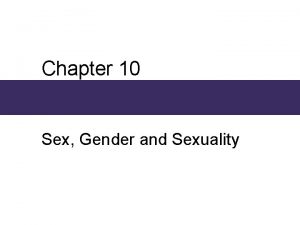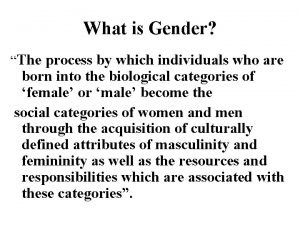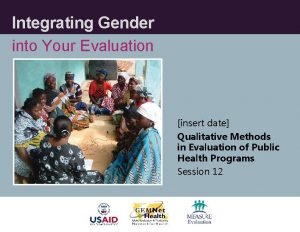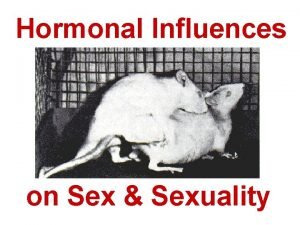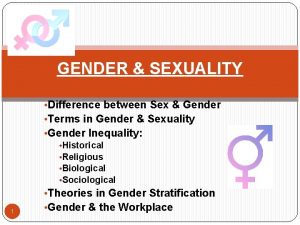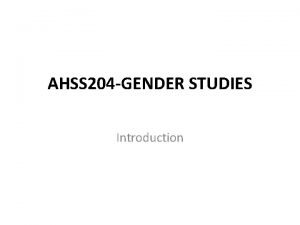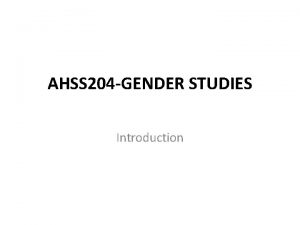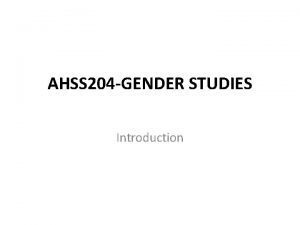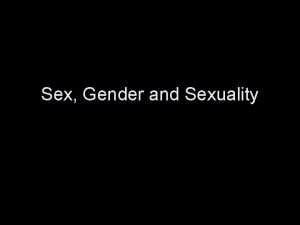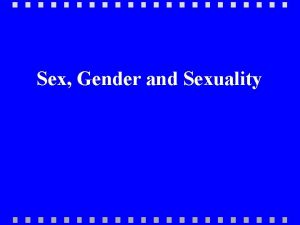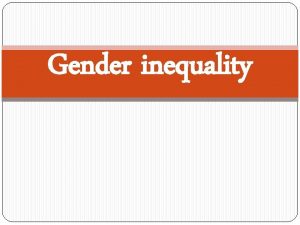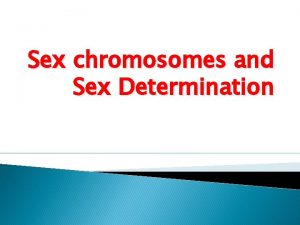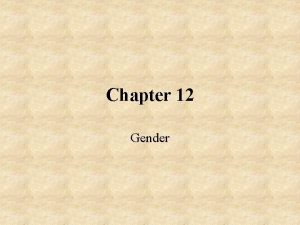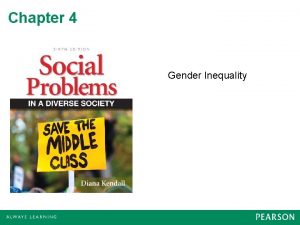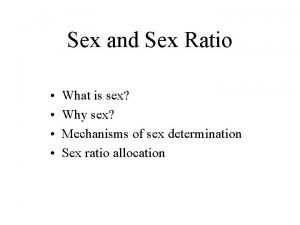AHSS 204 GENDER STUDIES Introduction Sex and Gender





























- Slides: 29

AHSS 204 -GENDER STUDIES Introduction: Sex and Gender by Assoc. Prof. Dr. Nurten Kara

Man or Woman? Is it important?

Gender signs

We learn gender roles in early ages

Social construction of sex and gender • Not only gender but our body is a cultural product as well: • Sex operations • Body building • Diet • Tatoo • piercing. . .

Private sphere: indoor


Public sphere: outside

(♀♂) • • Nature/culture femininity/masculinity Man/woman private/public • Women exclusion from the paid work help to lover the minimum vage • if women are kept in the house life expences such as child care, food, cleanning, elderly care, etc. can be reduced • A huge propaganda on keeping women indoor • Violence tolerated as form of control

Hannah Arendt’s concepts in political theory discussed in connection with violence (Economic, Physical, Pschological) Key concepts such as; • freedom, • political action, and • the public space Nurten Kara

POWER • Hannah Arendt: power is “the human ability not just to act but to act in concert” (1970, 44) • Hanna Pitkin: “that power is a something — anything — which makes or renders somebody able to do, capable of doing something. Power is capacity, potential, ability, or wherewithal” (1972, 276). Nurten Kara

Patriarchy • Walby defines 6 structures : -production relations -paid work -state -violence (of men) -sexuality -cultural organizations

Feminist Movements Liberal Feminism Marxist Feminism Socialist Feminism Radical Feminism Muslim Feminism Christian Feminism Black Feminism

Feminist contributions «The Private is Political» «The Personal is Political» Carol Hanisch • Is the motto of second wave feminism • It underscored the connections between personal experience and larger social and political structures since 60 s, 70 s, and until today • it is a challenge to the nuclear family and family values which has been exacerbated

UNDERSTANDING THE DIFFERENCE BETWEEN SEX AND GENDER • In many cultural contexts, the differences between girls and boys, and between men and women, are regarded as natural. • Children are classified at birth – usually by observing their genitals – into two categories: male and female. On the basis of the category to which they belong, society will consider them qualified to do certain things and expect certain attitudes and behavior of them. • Their rights and duties and their social, economic and political roles will be different during their childhood and throughout their adult lives.

All societies are organized around this basic social differentiation, which dominates the life of individuals to a considerable extent. • These categories have been pondered by philosophers, anthropologists and sociologists, who have shown that “femininity” and “masculinity” have no universal definitions: • a certain quality ascribed to men in one context will be ascribed to women in another; • a particular task patently considered to be female in one place will be regarded as male in another.

Thus the anthropologist Margaret Mead, studying traditional societies in Oceania in the first half of the twentieth century remarked on • “the conspicuous facts of age and sex. . . , - whether it be the convention of one Philippine tribe that no man can keep a secret, • the Manus assumption that only men enjoy playing with babies, • the Toda prescription of almost all domestic work as too sacred for women, • or the Arapesh insistence that women’s heads are stronger than men’s. ”

In many contemporary societies, these assertions could be reversed: women are considered more talkative than men, they are supposed to be naturally maternal and they are also thought to be better qualified to do domestic work. In some cultures, women carry a heavy load (in the Maghreb, for example) or maintain the roads (in Russia), whereas in others, they are believed to be physically too weak for such work. • This calls into question the naturalization of gendered identities. Differentiation between boys and girls and between men and women is based on anatomical differences, • but it is also a social construct. The concepts of “sex” and “gender” lead to a clearer understanding of the two elements in gendered identities. • •

“Sex” • refers to the biological differences between males and females. • It relates to the observable difference between their genitals and to their physiological functions in procreation.

“Gender” • is related to culture and the social division into “masculine” and “feminine”. • Gender therefore pertains to the qualities, tastes, aptitudes, roles and responsibilities associated with men and women in a society. • Definitions of masculine and feminine vary enormously – demonstrating their social origin – since every society develops its classification on the basis of its own criteria and principles. • The concepts of masculinity and femininity are not developed independently of each other but are mutually dependent.

It is common for sex and gender to be confused. • Biological differences between the sexes are the basis on which social differentiation of masculine and feminine is naturalized, and this is then considered beyond question. • The fact of being born male or female is, therefore, not sufficient in itself for a person to become a girl or a boy and, subsequently, a woman or a man within the social roles laid down by the society in which that person lives. • For this to happen, a learning process must take place from the moment that he or she is born.

The person will be confronted with expectations and requirements and also experience treatment, opportunities and events that will differ according to that person’s sex. • This experience will enable the person to assimilate all characteristics and roles assigned to both genders. • The daily learning process begins in the family and is continued by the institutions and members of society as a whole. • The gendered constraints imposed by society are thus internalized as natural.

As Simone de Beauvoir said, “One is not born a woman, one becomes one” similarly, one is not born a man but one becomes one. • These internalized gendered constraints provide a new understanding of the inequalities which exist between men, women and LGBT people. • These inequalities lead to a male/female bipolarization in all societies which is accompanied by the construction of a hierarchy. • Like social differentiation between the sexes, this hierarchy ought not to be legitimized by biological differences.

It is not natural; it is a social construct. • Unequal relations between men and women – male domination, female subordination – are therefore neither predestined nor immutable. • They are the outcome of a society’s “gender relations”. • These relations are usually unfavourable to women and detrimental in economic, social, legal, health and cultural terms.

Consequently, gender-sensitive policies and measures are designed to promote women in all spheres. It should be noted that gender relations and gender identities can also have adverse effects on men: • excess male mortality, for example, can be explained in part by types of social behavior associated with masculinity: drinking, smoking, speeding, and so on. • Schools and textbooks are fundamental to the learning of gendered roles. Representations of male and female are legitimized here by a high-status medium. • Once assimilated by children, the “gender system”, that is “the set of norms, beliefs, practices and knowledge that organizes relations between men and women”, will have repercussions on girls’ academic achievement and choices as well as on their experience as a whole. • It is from this angle that textbooks may be investigated as potential vehicles for gender equality.

United Nations Convention on the Elimination of All Forms of Discrimination against Women (CEDAW), • The Convention on the Elimination of All Forms of Discrimination against Women (CEDAW), adopted in 1979 by the UN General Assembly, is often described as an international bill of rights for women. Consisting of a preamble and 30 articles, it defines what constitutes discrimination against women and sets up an agenda for national action to end such discrimination.

CEDAW defines discrimination against women as ". . . any distinction, exclusion or restriction made on the basis of sex which has the effect or purpose of impairing or nullifying the recognition, enjoyment or exercise by women, irrespective of their marital status, on a basis of equality of men and women, of human rights and fundamental freedoms in the political, economic, social, cultural, civil or any other field. "

By accepting CEDAW States commit themselves to undertake a series of measures to end discrimination against women in all forms, including: • to incorporate the principle of equality of men and women in their legal system, abolish all discriminatory laws and adopt appropriate ones prohibiting discrimination against women; • to establish tribunals and other public institutions to ensure the effective protection of women against discrimination; and • to ensure elimination of all acts of discrimination against women by persons, organizations or enterprises.

CEDAW • The Convention provides the basis for realizing equality between women and men through ensuring women's equal access to, and equal opportunities in, political and public life -- including the right to vote and to stand for election -- as well as education, health and employment. States parties agree to take all appropriate measures, including legislation and temporary special measures, so that women can enjoy all their human rights and fundamental freedoms. • The Convention is the only human rights treaty which affirms the reproductive rights of women and targets culture and tradition as influential forces shaping gender roles and family relations. It affirms women's rights to acquire, change or retain their nationality and the nationality of their children. States parties also agree to take appropriate measures against all forms of traffic in women and exploitation of women. • Countries that have ratified or acceded to the Convention are legally bound to put its provisions into practice. They are also committed to submit national reports, at least every four years, on measures they have taken to comply with their treaty obligations.
 Sex sex sex
Sex sex sex Greenhouse sex
Greenhouse sex Xxtesticles
Xxtesticles Sex sex sex
Sex sex sex Sex sex sex
Sex sex sex Paradigm shift from women studies to gender studies
Paradigm shift from women studies to gender studies Sex 204
Sex 204 X linked dominant inheritance punnett square
X linked dominant inheritance punnett square Heterogametic
Heterogametic Sex determination and sex linkage
Sex determination and sex linkage Chapter 10 sex gender and sexuality
Chapter 10 sex gender and sexuality Difference between gender and sex
Difference between gender and sex The difference between sex and gender
The difference between sex and gender Sex
Sex Sex and gender difference
Sex and gender difference Difference between gender and sex
Difference between gender and sex Once a sex offender always a sex offender
Once a sex offender always a sex offender Strategic gender needs and practical gender needs
Strategic gender needs and practical gender needs Sex vs gender essay video
Sex vs gender essay video What is the importance of gender studies
What is the importance of gender studies Szpv 204
Szpv 204 Nkb no 204
Nkb no 204 What is binary
What is binary Gloucester county health department
Gloucester county health department Project arrow 204 sample test
Project arrow 204 sample test Bp form 204
Bp form 204 204
204 Nbn en 671-1
Nbn en 671-1 Wordle 204 3/6
Wordle 204 3/6 204/90 simplified
204/90 simplified










